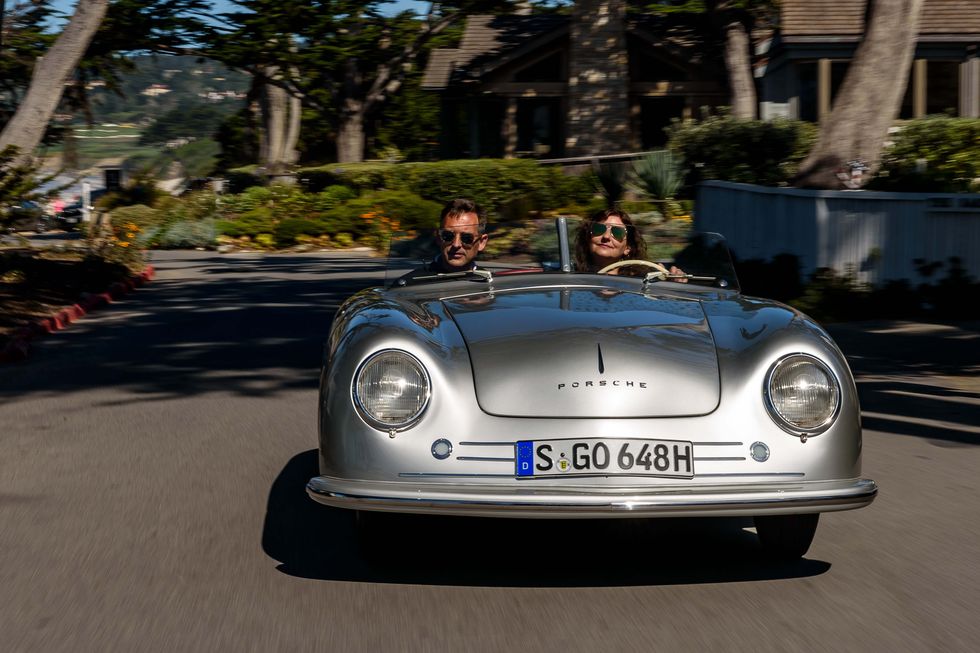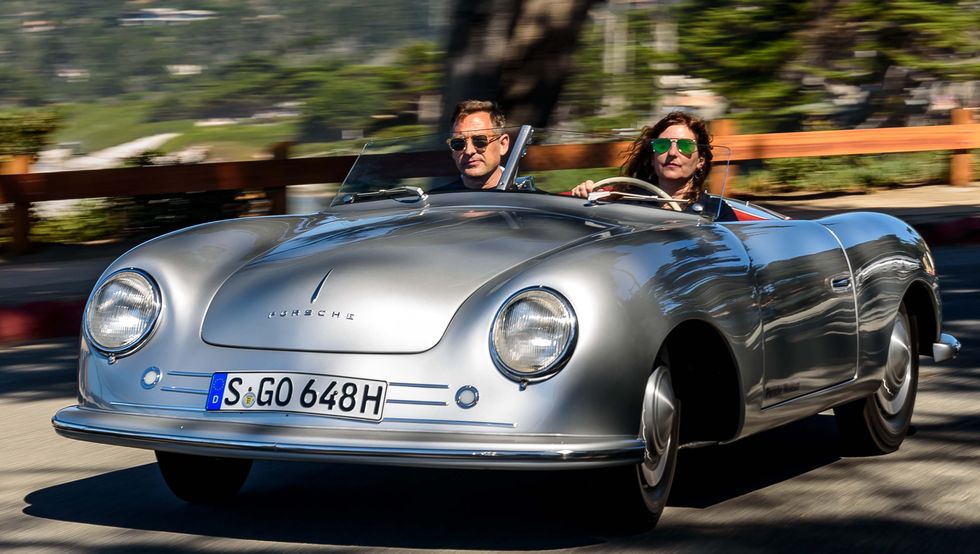At dinner the night before the drive, I was sat across from Kuno Werner, lead mechanic at the Porsche Museum. “Are you nervous to have us all drive your car?” I asked. Werner scanned the table of eager journalists and responded, “Yes.”
I probably should have been more nervous to be handed the keys. It’s hard to put a price on a car like the 356/1, but the Porsche Museum curator placed its value at nine figures. So I did feel some responsibility to keep the little bathtub in one piece, but mostly I was just thrilled. It’s so pretty and sweet, all dapper in silver and red. Its tires are barely bigger than those on an e-bike, its seats are about the size of the pull-down jump seats in a ’90s pickup truck. It doesn’t seem like a car so much as a movie prop. It seemed like it wanted to be driven, and I wanted to drive it.
The history of 356/1 is less murky than some prototypes, but it can get confusing. Often referred to as the first Porsche car, it’s really the first road-legal Porsche car. It’s the first car built by Porsche as a car company under the Porsche name. Before that, Ferdinand “Ferry” Porsche did design work for Volkswagen and built racecars like the turtley Type 64 in 1939, but they weren’t “Porsche cars.” Originally planned as a VW sports car, the 356/1 sits on a tube chassis with lightly modified VW chassis components under its hand-hammered aluminum shell. The 1.1-liter engine pumped out a whopping 35 horsepower. Somewhere along the line, the decision was made for this car to roll out under the Porsche brand name. Porsche had the 356/1 certified for road use on June 8, 1948, and the company uses that date, and this car, as its starting point.
For 356/1 though, the path to greatness was not a straight shot. Porsche was experimenting with various engine layouts for the 356, and while this prototype’s mid-engine format is exotic (and gives surprising luggage space both front and rear), it was hard to cool, made for a notchy and complex shifter linkage, and left very little room for the passengers. The rear engine would win for ease of production, and Porsche was developing those cars at almost the same time as he was working on 356/1. As soon as he knew which direction he wanted to pursue, he sold the mid-engine car to fund the production of the rear-engine versions.
The roadster went to Switzerland where it went through a series of owners over the next decade. Each made changes, from retrofitting the dash with a multi-gauge cluster from the 550 Spyder when that came out in the mid-fifties to redesigning the bodywork after a collision with a goat and an Opel. While today it seems crazy that Porsche would have sold his prototype car to people who didn’t give a hoot for its preservation, it’s more crazy (crazy cool) that Porsche recognized that car’s importance only 10 years later, and managed to track down and reacquire 356/1 in 1958.
Since then, the car has had several makeovers, as different curators focused on different parts of its history. Today the museum recognizes that its Swiss adventures are a part of its personality as much as its original form, so it’s a mix of original intent and later modifications. Adding to the confusion is a replica of 356/1 that more strictly represents the car’s first appearance; it has a duller finish and a bench seat interior. That car makes the rounds for museum display but isn’t a running machine. Achim Stejskal, director of the Porsche museum, says that there were discussions about completely restoring 356/1 to its 1948 appearance, but that this felt “less honest,” than allowing some of the changes to represent the car’s journey, details like the glossy silver paint and the well-worn red leather seats.
After checking my pockets for anything pointy—best practice for getting in any car—I slid into those red seats behind the 356/1’s pearl white banjo steering wheel. It’s as thin as a wine glass stem, that wheel, with perfectly finger-sized indentations on the backside. Behind it sits a single big speedometer, with an unusual reverse sweep and a possibly ambitious 160-km (99-mph) top speed. Certainly, we wouldn’t be testing that, as our route took us along the bluffs of Carmel-by-the-Sea, a road too narrow and too beautiful to speed by. Before the view though, I released the car’s beefy parking brake and notched the tiny doorknob of a shifter all the way forward. The clutch is light, the throttle lazy, but it didn’t even stutter as I eased it out into traffic.
On the road, the 356/1 feels like a Meyer’s Manx buggy dressed up for a party. It’s a mix of the wind in your hair and that old VW power delivery, a little slow off the line but building as you lay into the gas. It doesn’t handle like a dune buggy though, it’s low and tight. It must have felt outrageously nimble to anyone used to the heavy, floaty ride of most 1940s transport. Shifts are unsynchronized, but a little patient hangout in Neutral before moving to the next gear makes the transmission (and Kuno Werner) happy. As we drove by dog walkers and early morning joggers, everyone stopped to stare. The photographer told me later that someone asked him who the celebrity was. Make sense, it’s hard not to feel like Grace Kelly on the French Riviera with Clark Gable on a diamond heist while in the 356/1. It’s a confident kind of glamourous that even the shoutiest open-top sportscar on the market today can’t compete with. The only celebrity, of course, was the car itself.

Senior Editor, Features
Like a sleeper agent activated late in the game, Elana Scherr didn’t know her calling at a young age. Like many girls, she planned to be a vet-astronaut-artist, and came closest to that last one by attending UCLA art school. She painted images of cars, but did not own one. Elana reluctantly got a driver’s license at age 21 and discovered that she not only loved cars and wanted to drive them, but that other people loved cars and wanted to read about them, which meant somebody had to write about them. Since receiving activation codes, Elana has written for numerous car magazines and websites, covering classics, car culture, technology, motorsports, and new-car reviews.





